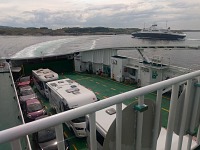 |
| Mortavika: freeway traffic did not even fill up our boat. Another one swings right in. |
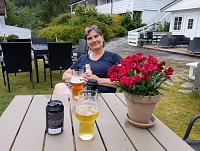 |
| Fotlandsvåg: we took a room at the Fjordslottet hotell and their beer's name is Tøsse Mølle. |
We enjoyed our morning meal with the knowledge of being about to venture into
wilderness — not literally, but in Norway, just like in Wyoming, there
are only a handful of large cities. We were headed for a village which might, or
might not, have a grocery store. Our current hotel, connected to a shopping mall
and inside a pedestrian zone with restaurants, was actually surrounded by
vibrant civilization (although, honestly, it could vibrate little less —
especially by one o'clock in the morning in the night club across the street
under our window). And I was still being nervous about those ships to Bergen.
We drove out on the "freeway", which in the Norwegian context means
that there are sometimes up to two lanes in each direction — and in good
time we reached a harbor — there, orderlies were lining cars into three
queues for passenger cars, and two more for trucks and trailers. We waited
for perhaps ten minutes before a ship arrived, disgorged a long line of cars,
and soon we were driving in. I was worried whether they'd let us step out and
if I'd be able to find a bathroom — yup, we got to park right next to
one. And one could, of course, roam the ship — and they have a free
wifi on, and refreshments (and more bathrooms, naturally). And a view deck, if
you wish to catch yourself some fresh air. Given the (hot) weather I was
imprudently wearing a skirt — and there was so much fresh air that I had
to hold my skirt down fast, to prevent Norwegians from reviewing my underwear.
Then we drove out on the freeway again and soon boarded another ship like the
total old hands we became — and I equipped myself with a hat and
a sweatshirt.
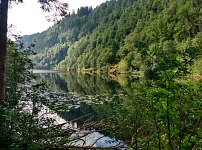 |
| Kossdalsvatnet: surrounding rocky slopes reflect in the lake's surface. |
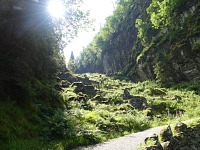 |
| Kossdalssvingane: up the switchbacked hill into the sun. |
We bypassed Bergen proper and continued onto Osterøy (East Island) —
though you may not notice on the map, the village of Fotlandsvåg IS on an island
surrounded by fjords from all sides. By then we were rushing down one lane
country roads — serving both directions — with an occasional passing
spot. All that typically on the ocean cliff's edge. Norwegians drive briskly and
don't worry their heads much about oncoming traffic — till today I'm
puzzled that we'd actually never seen any crash, or cars piled under the cliff.
It was getting late, and we decided to stop in Lonevåg and try finding some
dinner there. Google pointed to something Italian, but we ended up in a local
pub named Jafs, where they made me fish and chips — and poured beer for
us. Refreshed, we continued along horrible narrow roads to Fjordslottet Hotell.
A receptionist asked us where we were from and would not let us deflect her that
it was complicated. She noticed Hippo's official first name (Zdeněk) and it
turned out she herself was Slovak on a summer job. Our stay suddenly got much
friendlier, since we could drop a third language from our negotiations —
English. For example when we asked for a room with two beds or at least two
mattresses, to let us sleep. Eventually, Vanessa arranged a loft room for us,
where Hippo kept hitting his head when getting up from the bed, but where
we slept really well.
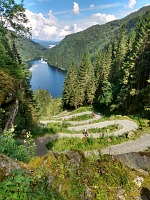 |
| Kossdalssvingane: 17 turns from top of the hill down to the valley. |
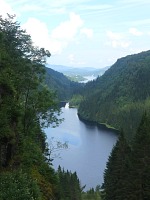 |
| Kossdal: a narrow valley with two lakes (the other can't be seen for the woods), Mjøsvågen bay and the fjord. |
We felt like walking a bit around —
slottet in Norwegian means
a palace — and Fjordslottet really started at the half of nineteenth
century as a noble residence of a wealthy founder of a cotton mill, which used
the local creek as principal energy source. Besides the main building, today's
hotel offers rooms in modern extensions — those have balconies, while our
little palace loft room had a soul. We decided to stretch our legs after sitting
in the car and on ships all day, and missed the closing hour in Joker —
the only local store — by mere minutes. We checked out the creek and the
fjord, and returned back to the hotel terrace, buying ourselves some local beer.
It was in a can, but very good — founded by a local miller and with
a funny name (Tøsse Mølle), which sounds like "it's milling" in Czech.
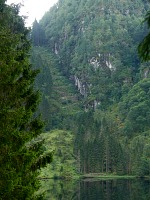 |
| Kossdalssvingane: it's possible to count the switchbacks through this gap in the trees. |
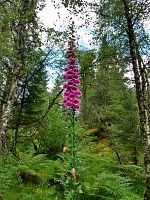 |
| Kossdalen: many magnificent violet foxglove plants beckoned us on our way. |
In the morning we set out to the main local attraction — Kossdalsvingane.
It's an old, no longer driven, road that overcomes an abrupt elevation gain of
574 feet (175 m). I think this was the first instance that I decided
to drive in Norway. Sid was supposed to navigate, and since we could not spot
any suitable parking, I let him direct me up a local way through hairpin
switchbacks, where even the Norwegians going the other way waited in the turns,
or backed into them. When it seemed that I would have to reverse into the same
swing, I was resolved to just flee — and apparently I also looked it, for
the car's driver in the other direction chose to back uphill instead of having
to watch me fit with our large Volvo into the passing spot. After this,
fortunately, Sid acceded to a defeat, we drove back downhill and parked near
a school in Hosanger. From there it was only a matter of few steps along the
road, before we managed to enter Kossdalen road, now pedestrian-only, but
maintained with sand and gravel. It was rather hot, on top of which Norway
sports much higher humidity than we are used to in Wyoming, so we were glad to
walk in a pleasant woodland. Still I huffed and sweated horribly, and felt quite
lame when we were meeting with merry greeting Norwegians, who were
enjoying a beautiful day and finally proper summer.
Scrambling up the seventeen switchbacks was not bad at all —
especially as one could blame one's frequent stopping on photography. There is
a lake at the foot of the switchbacks, and a fjord appears over time behind the
lake, and so there were plenty opportunities to take pictures, not MERELY as an
excuse. Benches are installed on top where one can rest and enjoy the view of
the conquered slope. We were by far not alone on this outing. From time to time
other tourists would emerge, both from below and from above, where another
parking is located; still it remained at a density when people greet each other
and exchange a few words.
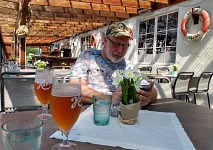 |
| Hosanger: we enjoyed the hospitality of Mjøsvågen Landhandleri. |
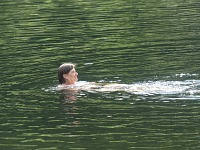 |
| Hosanger: Yeti Carol, however, thoroughly explores fjorden. |
Sky turned a bit overcast on our way down, and although it did not really rain,
it got muggier still. Hippo brought up the topic of food and I noted that I had
seen a turn-off down in Hosanger, to some café and another food place and
a public beach. Thus we found ourselves at Mjøsvågen Landhandleri, where we
partook in pizza and beer. Should you have the impression that we always drank
beer in Norway, you are correct — but I mention it mostly because beer
(and alcohol in general) is a rather fancy luxury there, as one beer sets you
back ten or more dollars.
We tried to enjoy that one beer a day even more. At Landhandleri
— which is something akin to American general store — they also
served food and draft beer on a covered terrace. And since this was NORWAY,
the terrace had a transparent roof — perhaps to let their guests enjoy
daylight and avoid rain — yet in the damp heat of this summer such roof
truly served as a hot-house. I longingly watched kids plunging from the shore on
the other side of the harbor, in the ocean, and a bathing plan took shape. When
shortly thereafter I discovered in the restroom that one can not only take (for
25 NOK = US$2.50) a shower there, but but also use the washer/dryer —
the decision was made.
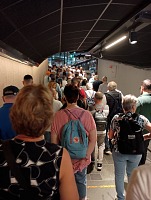 |
| Bergen Fløyenbanen: the funicular withstood the pressure of three giant cruise ships. |
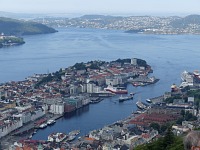 |
| Bergen's Old Harbor from the viewing platform at Fløyen. One of the giant cruise ships can be seen. |
We departed for the hotel to gather swim-suits and our dirty laundry — and
after making an arrangement at the store that we lack the VIPPS system, and
paying cash, we loaded the washer and went swimming. The beach has a developed
sandy shallow pool, but if you're brave, you can jump right into the fjord. This
deep inland, water seemed much warmer than in Fister.
There's a toilet at the entrance, grass is mowed, no
søppel
garbage anywhere, simply beautiful. Soon, though, we returned to the washer and
tried to figure out how to convince it to dry.
We only succeeded in part and about an hour later we lost patience; we grabbed
our half-wet things from its hot innards and hoped they would finish drying
at our room. I admit that the drying temperature set me aback — we had
many sports t-shirt and similar fragile things. Still it seems that the laundry
had survived and eventually finished drying overnight (which is a small miracle,
given Norwegian dampness).
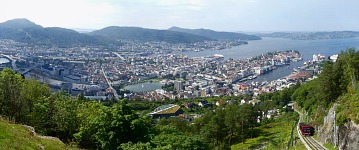 |
| Fløyen's panorama of Bergen with Redhette (Red Head) funicular wagon. |
We had a visit to Bergen on our list for Wednesday. Our friends had been there
on or two days earlier and recommended Bryggen — as they are apparently
more acculturated, and kept visiting attractions like fortresses and
monasteries.
We did not feel like spending time indoors during such beautiful days. I admit
that I did not even feel like seeing Bergen the city, such a country bumpkin I
have become. Hippo, however, enticed me to a funicular ride with a view, and the
fact they have goats up on the hill — and a lake where one can ride
canoes.
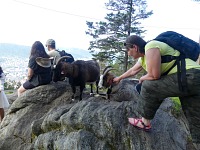 |
| Fløyen: you are a very pretty goat indeed. |
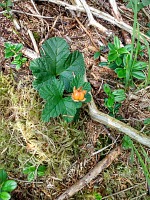 |
| Fløyen: unripe cloudberry. |
It was a short drive to Bergen — but that much longer we spent finding
parking — the first lot which we entered belonged to some hotel and had
no room anyway; only our second attempt was a correct one. It was a few steps
to the funicular, where, alas, a long queue stood out of the building. One could
expect it, for on our way we spotted three giant cruise ships in the harbor.
At least it moved rather quickly and soon we were pressed inside a small car
with other visitors. The train disgorged us up at Fløyen, onto a giant viewing
platform, among hundreds, perhaps even thousand tourists. After the quiet and
romantic Fjordslottet, this was a low blow. Still we took pictures of the
awesome view to Bergen, waded around a musical show, where some reedy sirens
loudly sang something quite out of tune. Tourists sat and milled about and
clapped, their taste being none of our business...
I must report that they really have goats at Fløyen — very tame, or more
likely, inert, but they let me scratch their beards and flatter them how pretty
goats they are. Then we went to look up the canoe lake. Ugh, such a small pond,
and a crazy long line to borrow the boat; we gave it up and went to buy ice
cream at a kiosk.
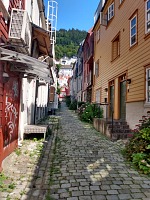 |
| Bergen: we found such pretty back alleys. |
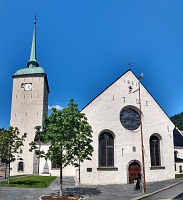 |
| Bergen: historic Korskirken church. |
Ice cream wrappings became søppel, which we attempted to discard into an
electronic self-compacting box that, after pushing a button, began to buzz
angrily rather than opening a søppel chute. By-the-rules Sid returned to the
kiosk to ask for advice or help, which he received in the form of a regular,
non-electronic waste bin, one they themselves use whilst keeping a safe
distance from progress. There were marked
trails leaving the kiosk in various directions — as it appears, this hill
is a starting point for multiple hiking routes — we have even seen people
packing stuff for several days. It seems to me a rather convenient
arrangement for locals — they take the funicular up the hill, from whence
they can embark on hiking trips. We, too, tried to venture into the woods, but
soon turned back. I wore my sandals, which obviously was sub-optimal footwear
for Norwegian swamps. At least we spotted some "multe" a.k.a.
cloudberries — special Nordic relatives of blackberries.
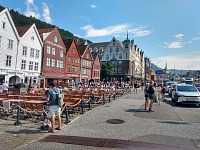 |
| Bergen: merchant district Bryggen, and up on the horizon the Fløyen viewing platform. |
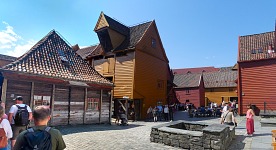 |
| Bergen: noble facades of Bryggen merchant houses lead to back yards with ancient shops. |
We had expected to walk down from Fløyen, but my sandals turned out to be the
obstacle again, as gravel from the paths kept getting into them —
cowardly, we opted for a funicular ride down. We tried to walk around the old
town, even entered the famous merchant district of Bryggen, but somehow it all
seemed over-touristed. And I longed for the quiet of "our" beach
on Osterøy. Till today I wonder how to explain that I liked a simple place like
Osterøy so much — possibly because I did not feel like a globe-trotting
sheep there. Lysefjord is awesome, but chock-full of visitors, and
Bergen is altogether crazy. We represented an exception on Osterøy —
summer staff at hotels and restaurants comes from abroad, but guests were mostly
Norwegians — who were open to a friendly chat with us; we felt like being
in a Norwegian Norway, and not at a World's Top Tourist Attraction #180.
A little boy, about 7 years old, hollered at us warningly, "klegg!"
(horseflies) at the beach, and he was not at all hard to understand. Plus the
whole network of tiny roads, strange local pubs and refreshments and general
stores, miniature beaches and a small loft room and summer weather —
all that evoked in me more "holidays" and relaxation, than touristy
chase after sensations. Add to it that we went to have a beer with Vanessa the
receptionist who was off duty that night, and the feeling of holiday was
fulfilled.
 |
| Hosanger: our beach, where Lusavågen bay changes name into Mjøsvågen. |
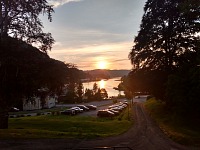 |
| Fotlandsvåg: late sunset from the Palace. |
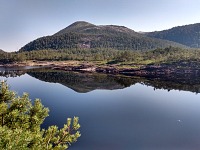 |
| Gangstø: Klubben (1,152 ft = 352 m) reflects in Austrevatnet Lake. |
All this apparently played its part, and thus we extended our stay at
Fjordslottet — and refrained from rushing on to the north and Trondheim,
or to the east and the Folgefonna National Park — as we reckoned that we
would spend many hours sitting in the car and subsequently have less time left
to actually visit the place. Our friends were just about then moving close to
Folgefonna, but even they eventually only had time to visit the nearby historic
Rosendal. Our grandpa had mused about having been on a trip to Norway long time
ago, somewhere on a beautiful high plateau near Bergen, and so we tried to
figure out what he could have meant — and there was Hardangervidda —
which would happen on our way back to Oslo, and thus we saved up for those two
extra days at the Slottet.
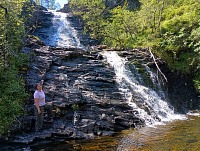 |
| Fossen: Carol being the scale for the local secret Waterfall with capital W. |
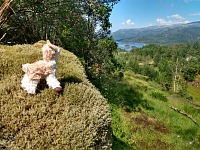 |
| Fossen Expedition: llama admires Vassdalen Valley and islands of the same name. |
There was a question what to do on the following day. The Isle offered a lot
of beautiful hikes up hills with views, but at eighty-five degrees we could
really not imagine scrambling up the tundra in full sunshine to some summit.
In the end we spotted Fossen — a local waterfall (with capital
W) — and decided to chance it. I drove, Sid was to navigate. The first
trap came in the fact that even this middle-sized island harbors two villages
named Kleppe. Still we had picked the correct one and soon we balanced on super
narrow roads that looked like leading directly to someone's back yard or even
kitchen. At the start of the road to the Falls there was not even a parking lot,
much less a sign, but Hippo claimed that according to the GPS, this was the
place. A grown-over two track led away, so it did not look too bad. Soon the
two-track disappeared and we stood under a steep ravine (are there any other in
Norway?) and pondered what next. Eventually we got up on top somehow and for
a while followed a whisper of a path. It vanished in the first bog. Keeping our
general direction by the GPS, we squished onward. After about an hour of
stumbling we found a path again that even looked made by people, which
eventually led us to a creek. The Waterfall was tiny by Norwegian standards,
and we had to wade through wild undergrowth to its bottom. Despite having spent
most of the time so far in a shady forest, we were totally soaked, and we found
this lonely, abandoned place convenient — we could take off our clothes
and splash and cool off a little bit, chasing away the risk of heat stroke.
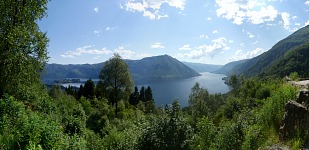 |
| Sørfjorden: a fjord with the Ulvsnesøy Island near Bruvik is simply named Southern. |
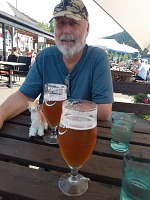 |
| Hosanger: our days on the Island tended to end at Mjøsvågen Landhandleri. |
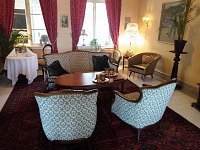 |
| Fjordslottet: saying good-bye to a historic dining hall at the Palace. |
I had imagined that our way back would be simpler. You can probably fill in the
rest. The treacherous path had vanished again and we, like two Swamp Monsters,
squished through the Norwegian wilderness — it was to be only a mile, but
it felt like trekking to the origins of the Amazon. I shall spare you further
commentaries, and keep quotes from this trip unquoted, but eventually we did
find our car — and decided not to go via the sneaky Kleppe, but via a TOWN
on the fjord. So: in Bruvik, those super-narrow roads are enhanced by houses
built on both sides — often with cars parked in the spots meant for
passing. If a house DOES NOT stand by one side, then this side FALLS steeply off
into the ocean. I bet even Amazonia does not have such horrors.
Despite all challenges, we still liked our trip to the Waterfall — mostly
because there were no people there at all, even though it's a beautiful place.
Still, we had to say good-bye to our holiday stay — we swam at our
favorite beach, had a beer at Landhandleri — and topped it off with a fancy
dinner at the Palace. Until then, we refrained from dining there (except for
those awesome real Norwegian breakfasts), as the restaurant tended to be booked
full on evenings and, why hide it, on the expensive side. I felt a little
sad for leaving, but we still had mountains, waterfalls — and
Hardangervidda and a glacier — ahead of us, which promised a bit of
cooling off.































